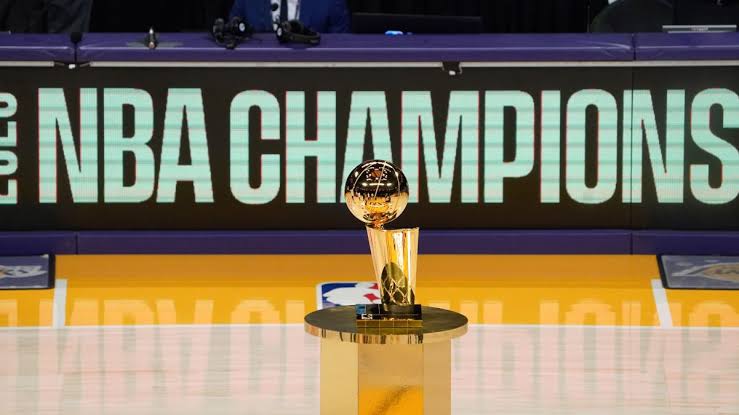
Why is one of the most thrilling plays in the game being sued by the league?
Most G-Leaguers will never pull off a play that gets them the side-by-side treatment with Michael Jordan, but Celtics draftee Jordan Walsh earned his trending status on Tuesday.
Flying through the lane like a cold-blooded Arya Stark hellbent on vengeance, Walsh put back a missed free throw with a thunderous dunk that forced him practically sideways.
It evoked memories of Jordan piercing the Blazers to throw down a Scottie Pippen miss 30 years ago and it turned an otherwise sleepy gym in Mississauga, Ontario into ground zero for “holy crap, did that just happen?”
In the course of converting his marvelously athletic play, Walsh held onto the rim. With his body swinging nearly parallel to the floor, he countered his momentum by holding on for dear life while boomeranging back towards the lane.
Perhaps it was the final pull-up, or maybe it was the slightly splayed legs, but Walsh’s career highlight was quickly marred by the worst call in professional sports: the technical foul for hanging on the rim.
For a league that has expertly finessed its product into a showcase for some of the most creative athletes in the world, the NBA’s focus on rim-hanging T’s feels pointlessly anachronistic. It’s guaranteed to draw groans from both home and rival fans, and yet we see the call everywhere, from the highest levels of the NBA on TNT, to random G League tilts in Canada, down to high school and college games for anyone who can jump that high.
The question is, why? It feels like a misguided callback to the 1990s, when the NBA grew so concerned the game had turned “thuggish” that it legislated any flair into oblivion for fear it would alienate the audience. This was problematic for many reasons, particularly cultural, but it turns out that fan sensibilities aren’t as delicate as the powers-that-be once believed.
We can handle guys hanging on the rim just fine. In fact, it’s probably the one act on the court that most acutely highlights the difference in athleticism between an NBA player and a regular human being.
Plenty of us can make a 3-pointer from 35 feet like Steph Curry. A good high school point guard can properly execute a Shammgod dribble. There’s a tiny segment of the population that on their best day could dunk, even if it’s just a tennis ball.
But soar through the air, jackhammer an alley-oop, and then do a chin-up on the rim? We can only leave that one to the pros and marvel at the combination of power and grace … before wincing at the needless, buzz-killing whistle.
The Celtics have been particularly victimized this season, with Kristaps Porzingis getting nailed after a transition dunk in Philadelphia in November, and Jayson Tatum earning a T for a give-and-go slam a couple of weeks later in Orlando when he hoisted himself over Paulo Banchero on the follow-through.
By the letter of the law, both players broke the rules. “Players are not allowed to pull themselves up on the rim, nor are they allowed to hang on the rim after a dunk attempt, unless they are doing so to avoid injury to themselves or another player,” says the league’s handbook.
Ugh, no. When a call is universally reviled, it’s probably time to reconsider its merits.
Ask yourself this: when was the last time a dunk wasn’t called for excessive hanging and it upset you? The answer is never, with the possible exception of Shaq hoisting his junk into Chris Dudley’s face 25 years ago. No one wants that call, and yet we’ve seen it whistled on some of the league’s biggest stars, including Tatum, Giannis Antetokounmpo, and LeBron James.
It’s stupid for aesthetic reasons, but safety ones, too. Even though the league makes an exception for “avoiding injury,” that risk is in the eye of the rim holder, who isn’t exactly blessed with time to weigh his options. After Walsh’s transgression, for instance, he immediately pleaded that a rival player was under the basket.
Tatum has made similar arguments, and the fear is that in their desire to avoid another technical, some superstar will get hurt letting go when he should’ve held on.
“That’s a rule they just implemented that quite frankly I don’t think makes any sense,” Tatum said in November. “They want to protect the players, but anybody that’s ever played, your momentum pulls you that way. You’re just trying to make sure you’re good. Maybe they just want me to let go and see what happens.”
For a league and a sport that gets so much right, it’s baffling how the NBA could get this call so wrong. Whether you’re Michael Jordan or Jordan Walsh, a high-flying dunk is the one surefire way to bring fans to their feet. No one wants the moment ruined by a whistle and a referee gesturing like some kind of angry librarian.
Leave a Reply